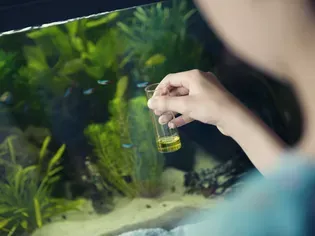14 Best Floating Plants for Your Aquarium
Updated on 04/26/24

14 Best Floating Plants for Your Aquarium: A Comprehensive Guide to Enhance Beauty and Ecosystem
Introduction
Embellish your aquatic habitat with the ethereal charm and ecological benefits of floating plants! These captivating species, adept at gracefully adorning the water's surface, not only elevate the visual appeal of your aquarium but also play a crucial role in maintaining a healthy ecosystem. In this comprehensive guide, we'll delve into the captivating world of floating plants, exploring 14 exceptional species that will transform your aquarium into a verdant paradise.
Benefits of Floating Plants in Aquariums
* Enhanced Aesthetics: Floating plants add visual interest and depth to aquariums, creating a sense of tranquility and natural ambiance.
* Water Quality Control: They absorb excess nutrients from the water column, helping to prevent algae growth and maintain water clarity.
* Oxygenation: As photosynthetic organisms, floating plants release oxygen into the water, increasing dissolved oxygen levels for fish and other aquatic life.
* Breeding Habitat: The dense root systems of floating plants provide hiding places for fry and shrimp, enhancing their survival rates.
* Surface Cover: They reduce the amount of light reaching the bottom of the aquarium, deterring bottom-dwelling algae growth.
Types of Floating Plants
Numerous floating plant species exist, each with unique characteristics and requirements. Here are some of the most popular types:
* Duckweed (Lemna minor): Tiny, free-floating plants that form dense mats on the water's surface.
* Frogbit (Limnobium laevigatum): Larger, rounded leaves with a rosette shape.
* Water Sprite (Ceratopteris thalictroides): Delicate, fern-like leaves that float or grow submerged.
* Amazon Frogbit (Limnobium amazonicum): Similar to frogbit, but with larger, elongated leaves.
* Salvinia natans: Free-floating plants with star-shaped leaves.
* Water Hyacinth (Eichhornia crassipes): Large, bulbous plants with thick stems and showy purple flowers.
14 Best Floating Plants for Your Aquarium
Now, let's explore 14 exceptional floating plant species that will beautify and enhance your aquarium ecosystem:
1. Salvinia Minima
* Small, clover-shaped leaves with a vibrant green color.
* Ideal for small aquariums due to its compact size.
* Helps reduce nitrate levels.
2. Salvinia Auriculata
* Larger than Salvinia minima, with oval-shaped leaves.
* Known for its ability to absorb heavy metals from the water.
* Provides excellent hiding places for fry.
3. Azolla Caroliniana
* Tiny, fern-like leaves that form dense mats.
* Fixes nitrogen from the atmosphere, reducing the need for fertilizers.
* Ideal for breeding aquariums as it provides dense cover for fry.
4. Water Lettuce (Pistia stratiotes)
* Large, rounded leaves with a velvety texture.
* Provides shade and reduces surface agitation.
* Easy to care for, but requires high light levels.
5. Riccia Fluitans
* Moss-like plant that forms dense mats on the water's surface.
* Can be attached to driftwood or rocks for added interest.
* Ideal for shrimp tanks as it provides hiding and feeding opportunities.
6. Duckweed (Lemna minor)
* Tiny, free-floating plants that reproduce rapidly.
* Effective at absorbing nitrates and phosphates.
* Can become invasive if not controlled.
7. Wolffia Angusta
* The smallest flowering plant in the world.
* Forms dense mats that can cover the entire water surface.
* An excellent food source for small fish and fry.
8. Frogbit (Limnobium laevigatum)
* Rounded, glossy leaves with a rosette shape.
* Provides excellent shade and hiding places for fish.
* Can also be grown submerged.
9. Amazon Frogbit (Limnobium amazonicum)
* Larger than frogbit, with elongated leaves.
* Known for its ability to absorb ammonia and nitrates.
* Prefers high light levels.
10. Water Sprite (Ceratopteris thalictroides)
* Fern-like leaves that float or grow submerged.
* Provides oxygenation and cover for fish and invertebrates.
* Easy to care for and propagates quickly.
11. Rotala Rotundifolia
* Floating form of the popular submerged plant.
* Features round, reddish leaves.
* Adds color and interest to the water's surface.
12. Hygrophila Polysperma
* Another floating form of a submerged plant.
* Produces long, trailing stems with small, oval leaves.
* Creates a dense canopy that provides shade and hiding places.
13. Ceratophyllum Demersum (Hornwort)
* Submerged plant that can also float.
* Known for its ability to absorb nitrates and phosphates.
* Provides excellent hiding places for fry.
14. Eichhornia Crassipes (Water Hyacinth)
* Large, bulbous plants with thick stems.
* Produces showy purple flowers.
* Effective at removing excess nutrients from water.
Care and Maintenance of Floating Plants
Caring for floating plants is relatively easy. Here are some tips:
* Lighting: Most floating plants require moderate to high lighting levels. Provide adequate lighting to ensure healthy growth and prevent excessive shading.
* Nutrients: Floating plants are generally undemanding in terms of nutrients. However, they may benefit from occasional fertilization, especially nitrogen-rich fertilizers.
* Pruning: Regularly trim floating plants to remove excess growth and maintain their desired size and shape.
* Control: Some floating plants, such as duckweed, can spread rapidly. Monitor their growth and remove excess plants as needed to prevent overgrowth.
Conclusion
Incorporating floating plants into your aquarium is an excellent way to enhance its beauty and ecological balance. The 14 species described in this guide provide a diverse range of options to choose from, ensuring that you can find the perfect plants to complement your aquatic habitat. Remember, proper care and maintenance are crucial to maintaining the health and longevity of your floating plants. So, embrace the enchanting world of floating plants and elevate your aquarium to a vibrant and thriving ecosystem!
Explore More Pets

Freshwater Aquarium Filters
How to Deal With Cloudy Aquarium Water

Saltwater Aquarium Filters
How Do You Remove Chloramines From Tap Water?

Freshwater Aquariums & Habitat
Can I Keep My Koi Fish Inside?

Freshwater Fish Health
How to Treat Ich on Freshwater Fish

Saltwater Fish Health
Fin Rot in Aquarium Fish

Freshwater Aquarium Filters
How to Do Aquarium Water Changes

Saltwater Fish Health
How Do Fish Get Parasites?

Freshwater Aquarium Filters
Aquarium Water Parameters to Control for Healthy Fish